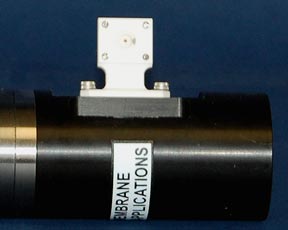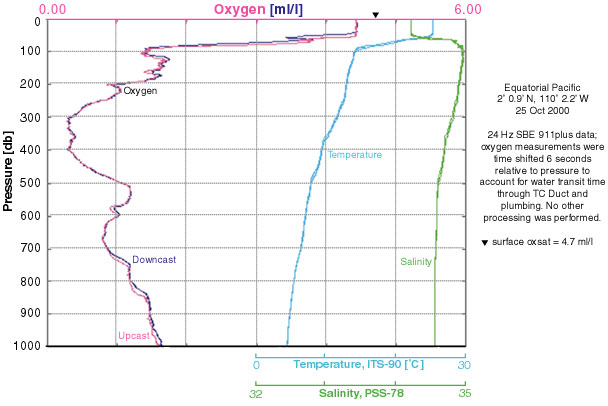 Dissolved Oxygen (DO) Sensor
Dissolved Oxygen (DO) Sensor SBE 43
 Dissolved Oxygen (DO) Sensor
Dissolved Oxygen (DO) Sensor
![]() Print version Configuration
options & accessories -
SBE 43 (0-5
Volt output) or
SBE 43F
(frequency output)
Trade-In Program to replace SBE 13Y & 23Y
Print version Configuration
options & accessories -
SBE 43 (0-5
Volt output) or
SBE 43F
(frequency output)
Trade-In Program to replace SBE 13Y & 23Y
 |
 |
The SBE 43 sets the oxygen measurement standard for oceanographic research. The sensor is a complete redesign of the Clark polarographic membrane type in which careful choices of materials, geometry, and sensor chemistry are combined with superior electronics interfacing and calibration methodology to yield major gains in performance.
Calibration stability is improved by an order of magnitude, and the sensor requires less frequent calibration. Calibration drift is caused primarily by membrane fouling from ocean contaminants, and less so by chemical processes inside the sensor. If the membrane is kept clean, the sensor’s improved chemical stability yields demonstrated calibration drift rates of less than 0.5% over 1000 hours of operation (on time).
Temperature response is dramatically improved. The chemical and physical processes that underlay the oxygen measurement are very sensitive to temperature. Accurate characterization of the internal sensor temperatures that control these processes, especially when water temperature is changing rapidly, is a key accomplishment of this design. Not only does the SBE 43 sensor measure temperature in the right place: the temperature equilibration time of the entire sensor head has been reduced to a few seconds, so it tracks the changing water temperature much more faithfully.
Hysteresis is largely eliminated in the upper ocean (1000 meters) due to improved temperature response. Residual mismatch between up and down casts in this part of the ocean is due to sensor alignment, correctable in post-processing. At higher pressures, changes occur in gas-permeable Teflon membranes that affect their permeability characteristics. These changes have long time constants, depend on the sensor's time-pressure history, and result in hysteresis at depths greater than 1000 meters. These effects are predictable and are also correctable in post-processing. The resultant SBE 43 measurement resolves oxygen features more precisely, reducing the ambiguity about locking measured sensor values to bottle Winklers.
Continuous polarization eliminates stabilization wait-time after power-up. The sensor is always ready for immediate use. Earlier sensors required several minutes to polarize following power-up. During that time, sensor readings were inaccurate. In the SBE 43, micropower electronics and an internal, five-year, board-mounted battery eliminate power-up delay.
Poisoning in hydrogen sulfide environments was a phenomenon common to early oxygen sensor designs that used silver as the cathode element. The SBE 43 uses a noble metal (gold) as the cathode and silver as the anode, and shows no degradation of signal or calibration when used for profiling in hydrogen sulfide environments.
Signal resolution is increased by on-board temperature compensation, and a CTD channel is made available for other purposes because there is no temperature output signal. Even when oxygen concentration is constant, the normal range of ocean temperatures causes the output of earlier sensors to vary by a factor of two. The SBE 43’s internal temperature compensation eliminates this variation, allowing the sensor to pre-amplify the signal proportionately; resolution with existing CTD systems is correspondingly increased.
Effective plumbing strategies allow for longer moored deployments. Plumbing isolates the SBE 43 from continuous exposure to the external environment, allowing trapped water to go anoxic, minimizing electrolyte consumption between samples. The black plenum and installing black tubing block light, reducing in-situ algal growth.
A 5-year warranty backs the sensor’s integrity. During the warranty period, one sensor re-charge (electrolyte refill, membrane replacement, and recalibration) will be performed at Sea-Bird free of charge.

Configuration Options
The SBE 43 voltage output sensor can be integrated with any Sea-Bird CTD that accepts 0 - 5 volt auxiliary sensor input (for example, SBE 9plus, 16, 16plus, 16plus-IM, 16plus V2, 16plus-IM V2, 19, 19plus, 19plus V2, 25, 25plus). Configuration choices include:
The SBE 43F frequency output sensor can be integrated with an SBE 52-MP or Glider Payload CTD, or used for OEM applications (requires OEM circuit board). It is available with a 600-meter plastic or 7000-meter titanium housing. Another version of the SBE 43F is used as an integral part in SBE 37 MicroCATs (IMP-IDO, SMP-IDO, or SIP-IDO),
Specifications
| Measurement range | 120% of surface saturation in all natural waters, fresh and salt |
| Initial accuracy | ± 2% of saturation |
| Typical stability | 0.5% per 1000 hours (clean membrane) |
| Response time Tau | 2 to 5
seconds for 0.5-mil membrane, 8 to 20 seconds for 1.0-mil membrane Time to reach 63% of final value for a step change in oxygen; dependent on ambient water temperature and flow rate (see Application Note 64 for discussion) |
| Input power | 6.5 - 24 VDC,
60 milliwatts (SBE 43) or 45 milliwatts (SBE 43F) |
| Output signal | 0 - 5 VDC (SBE 43), frequency (SBE 43F) |
| Housing / depth rating | Plastic
housing: 600-meter (1960 feet) Titanium housing: 7000-meter (22,900 feet) (10,500-meter titanium housing available on request) |
| Weight | SBE 43
-- Titanium housing: 0.7 kg (1.5 lbs) in air, 0.4 kg (0.9 lbs) in water Plastic housing: 0.5 kg (1.1 lb) in air, 0.1 kg (0.2 lbs) in water SBE 43F -- Titanium housing: 0.4 kg (0.9 lbs) in air, 0.2 kg (0.4 lbs) in water Plastic housing: 0.3 kg (0.7 lbs) in air, 0.1 kg (0.2 lbs) in water |
|
SBE 43 Voltage Output Sensor
|
SBE 43F Frequency Output Sensor
(for 52-MP, Glider Payload CTD, and OEM applications)
|
ADDITIONAL INFORMATION / LINKS:
Documentation -- manual, photos, technical papers, application notes, etc.
Sales Information -- options, accessories, cables, mount kits, spares, etc.
Links to Other Instruments of Interest
![]()
Specifications are subject to change without notice.
Sea-Bird Home Phone: (+1) 425-643-9866 E-mail: seabird@seabird.com